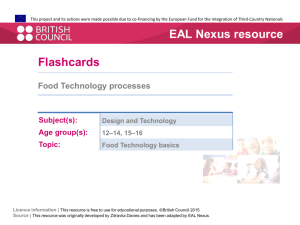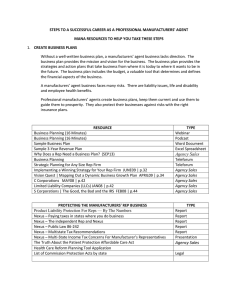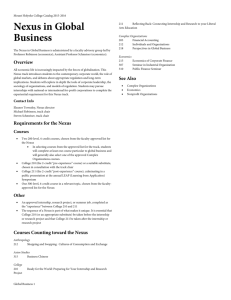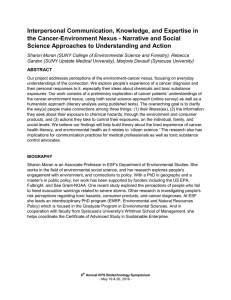Nexus: A New Operating System for Trustworthy Computing
advertisement
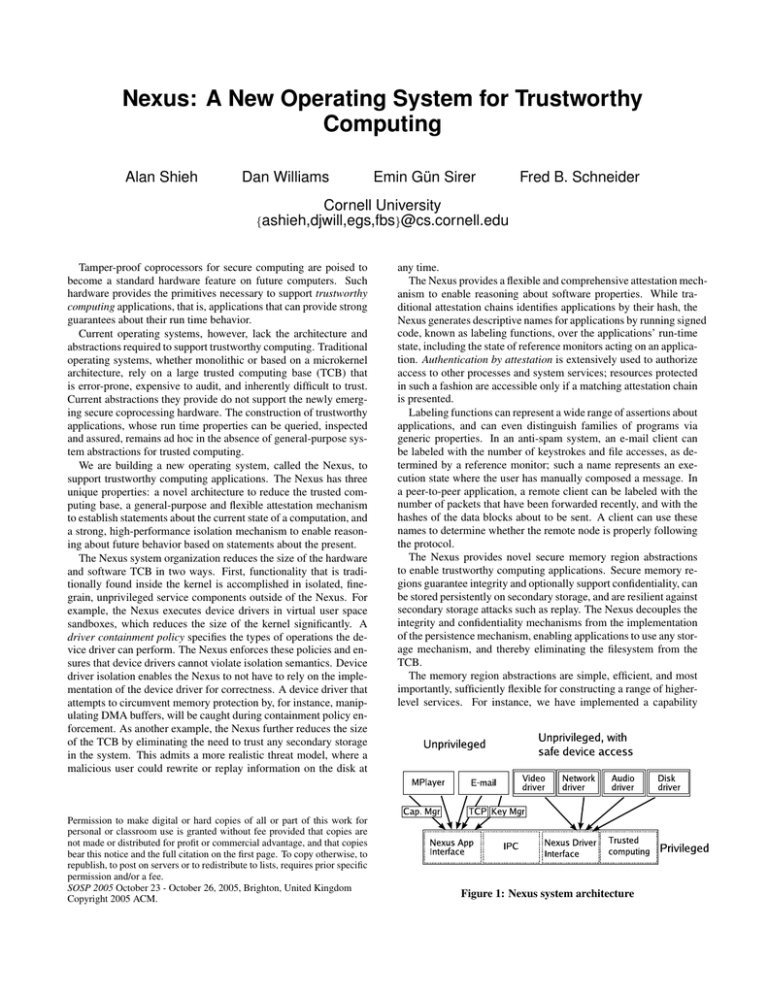
Nexus: A New Operating System for Trustworthy
Computing
Alan Shieh
Dan Williams
Emin Gün Sirer
Fred B. Schneider
Cornell University
{ashieh,djwill,egs,fbs}@cs.cornell.edu
Tamper-proof coprocessors for secure computing are poised to
become a standard hardware feature on future computers. Such
hardware provides the primitives necessary to support trustworthy
computing applications, that is, applications that can provide strong
guarantees about their run time behavior.
Current operating systems, however, lack the architecture and
abstractions required to support trustworthy computing. Traditional
operating systems, whether monolithic or based on a microkernel
architecture, rely on a large trusted computing base (TCB) that
is error-prone, expensive to audit, and inherently difficult to trust.
Current abstractions they provide do not support the newly emerging secure coprocessing hardware. The construction of trustworthy
applications, whose run time properties can be queried, inspected
and assured, remains ad hoc in the absence of general-purpose system abstractions for trusted computing.
We are building a new operating system, called the Nexus, to
support trustworthy computing applications. The Nexus has three
unique properties: a novel architecture to reduce the trusted computing base, a general-purpose and flexible attestation mechanism
to establish statements about the current state of a computation, and
a strong, high-performance isolation mechanism to enable reasoning about future behavior based on statements about the present.
The Nexus system organization reduces the size of the hardware
and software TCB in two ways. First, functionality that is traditionally found inside the kernel is accomplished in isolated, finegrain, unprivileged service components outside of the Nexus. For
example, the Nexus executes device drivers in virtual user space
sandboxes, which reduces the size of the kernel significantly. A
driver containment policy specifies the types of operations the device driver can perform. The Nexus enforces these policies and ensures that device drivers cannot violate isolation semantics. Device
driver isolation enables the Nexus to not have to rely on the implementation of the device driver for correctness. A device driver that
attempts to circumvent memory protection by, for instance, manipulating DMA buffers, will be caught during containment policy enforcement. As another example, the Nexus further reduces the size
of the TCB by eliminating the need to trust any secondary storage
in the system. This admits a more realistic threat model, where a
malicious user could rewrite or replay information on the disk at
Permission to make digital or hard copies of all or part of this work for
personal or classroom use is granted without fee provided that copies are
not made or distributed for profit or commercial advantage, and that copies
bear this notice and the full citation on the first page. To copy otherwise, to
republish, to post on servers or to redistribute to lists, requires prior specific
permission and/or a fee.
SOSP 2005 October 23 - October 26, 2005, Brighton, United Kingdom
Copyright 2005 ACM.
any time.
The Nexus provides a flexible and comprehensive attestation mechanism to enable reasoning about software properties. While traditional attestation chains identifies applications by their hash, the
Nexus generates descriptive names for applications by running signed
code, known as labeling functions, over the applications’ run-time
state, including the state of reference monitors acting on an application. Authentication by attestation is extensively used to authorize
access to other processes and system services; resources protected
in such a fashion are accessible only if a matching attestation chain
is presented.
Labeling functions can represent a wide range of assertions about
applications, and can even distinguish families of programs via
generic properties. In an anti-spam system, an e-mail client can
be labeled with the number of keystrokes and file accesses, as determined by a reference monitor; such a name represents an execution state where the user has manually composed a message. In
a peer-to-peer application, a remote client can be labeled with the
number of packets that have been forwarded recently, and with the
hashes of the data blocks about to be sent. A client can use these
names to determine whether the remote node is properly following
the protocol.
The Nexus provides novel secure memory region abstractions
to enable trustworthy computing applications. Secure memory regions guarantee integrity and optionally support confidentiality, can
be stored persistently on secondary storage, and are resilient against
secondary storage attacks such as replay. The Nexus decouples the
integrity and confidentiality mechanisms from the implementation
of the persistence mechanism, enabling applications to use any storage mechanism, and thereby eliminating the filesystem from the
TCB.
The memory region abstractions are simple, efficient, and most
importantly, sufficiently flexible for constructing a range of higherlevel services. For instance, we have implemented a capability
Figure 1: Nexus system architecture
manager for managing general-purpose object capabilities based
on the confidential, integrity-protected memory region abstraction.
This capability manager can implement general-purpose security
automata [6], which can capture, encode, and act on past state in
making access control decisions. Implementing such a service with
current systems is difficult, as they are vulnerable to replay attacks
on the disk. The Nexus thus supports linear capabilities, which
provide a hard limit on the number of times a capability can be
used. The flexibility of the low-level memory region abstraction
provided by the Nexus enables the capability manager to be implemented entirely in user space. In contrast, capabilities are typically
implemented in the kernel on traditional systems, increasing TCB
size and forcing applications to use a specific interface and implementation.
We have implemented the Nexus kernel and user services on x86
hardware, along with several applications that use the new trustworthy computing abstractions that the Nexus and middleware services
provide. One such application is a media player, which uses the capability manager to obtain a linear capability to play a movie a limited number of times. Only a media player that matches the labeling
function authorized to obtain a linear capability, for instance, one
that runs in a reference monitor that blocks network and file writes,
can request the capability, and the capability will only be granted
for the first k viewings. We have also implemented a spam-resilient
e-mail system, which labels e-mail clients with a labeling function
(as described above) indicating that a message has been typed by a
human. The attestation chain is sent with the message, which can
be examined at the recipient, who then knows that the message is
unlikely to be spam, and presents the message to the user.
The Nexus differs fundamentally from past work on creating a
trustworthy execution environment. The XOMOS system [3, 4] explored new processor architectures to enable trustworthy computing, and posited a system design where the secure processor would
obviate trust in the operating system. However, since the required
changes affect the central processor, and have numerous performance implications, this approach remains unadopted by industry.
In contrast, the Nexus is designed to work on top of the commonlydeployed secure coprocessors, known as trusted platform modules,
that are an industry standard [8]. Pioneer provides a dynamic root
of trust for an attestation-like mechanism called verifiable code execution for legacy platforms that lack a TPM [7]. It may be possible
to combine verifiable code execution with a trusted dispatcher infrastructure to provide sufficient attestation guarantees to replace
the TPM from the Nexus TCB. The TCGLinux system [5] proposed adding attestation capabilities to Linux. This approach fails
because it does not take steps to reduce the large trusted computing
base that a Linux system entails, or to provide isolation between applications. It is all too easy to use the latest Linux security advisory
to compromise the system and produce falsified attestation certificates (by, for instance, attesting to an intact but disabled version
of the original service, while executing a different, compromised
version). Terra [2] is an execution environment for trustworthy
computing based on virtualization. The TCB is composed of the
Terra virtual machine monitor (VMM), which provides isolation
between trusted applications by creating distinct virtual execution
on the same physical computer for each application, and attests
to the load-time contents of each virtual machine. Attestation in
Terra generates a single hash describing an entire virtual machine.
Since each application requires a full-blown virtual machine, this
approach does not scale well with increasing numbers of domains
(e.g. applications). Terra executes drivers at high privilege, so its
TCB is larger than that of Nexus. While Asbestos [1] does not
directly address trustworthy computing, its characterization of the
label passing interactions between components is a useful run-time
policy that can be encoded within Nexus attestation chains.
Acknowledgments
Supported in part by AFOSR grant F49620-03-1-0156, National
Science Foundation Grants 0430161 and CCF-0424422 (TRUST),
ONR Grant N00014-01-1-0968, and a grant from Intel Corporation.
References
[1] P. Efstathopoulos, M. Krohn, S. VanDeBogart, C. Frey,
D. Ziegler, E. Kohler, D. Mazieres, M. F. Kaashoek, and R. T.
Morris. Labels and Event Processes in the Asbestos Operating
System. In Proceedings of the Symposium on Operating
Systems Principles, Brighton, UK, Oct. 2005.
[2] T. Garfinkel, B. Pfaff, J. Chow, M. Rosenblum, and D. Boneh.
Terra: A Virtual Machine-Based Platform for Trusted
Computing. In Proceedings of the Symposium on Operating
Systems Principles, Bolton Landing, NY, Oct. 2003.
[3] D. Lie, C. Thekkath, and M. Horowitz. Implementing an
Untrusted Operating System on Trusted Hardware. In
Proceedings of the Symposium on Operating Systems
Principles, Bolton Landing, NY, Oct. 2003.
[4] D. Lie, C. Thekkath, M. Mitchell, P. Lincoln, D. Boneh,
J. Mitchell, and M. Horowitz. Architectural Support for Copy
and Tamper Resistant Software. ACM SIGPLAN Notices,
35(11):168–177, 2000.
[5] R. Sailer, X. Zhang, T. Jaeger, and L. van Doorn. Design and
Implementation of a TCG-based Integrity Measurement
Architecture. In Proceedings of the 13th Usenix Security
Symposium, pages 223–238, August 2004.
[6] F. B. Schneider. Enforceable security policies. ACM
Transactions on Information and System Security, 3(1):30–50,
2000.
[7] A. Seshadri, M. Luk, E. Shi, A. Perrig, L. van Doorn, and
P. Khosla. Pioneer: Verifying Integrity and Guaranteeing
Execution of Code on Legacy Platforms. In Proceedings of the
Symposium on Operating Systems Principles, Brighton, UK,
Oct. 2005.
[8] Trusted Computing Group. TPM Specification Version 1.2.
